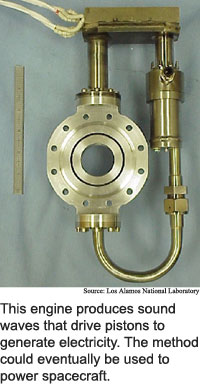
Sound makes electricity for
space
Generating electricity is all about changing
one source of energy into another.
Researchers from Los Alamos National Laboratory and Northrop Grumman
Space Technology have built a compact generator that converts heat to
electricity with the relatively high efficiency of 18 percent.
The generator is simple, making it potentially long-lived and
easy to maintain. This makes it especially appropriate for generating
electricity aboard spacecraft, according to the researchers.
The generator uses a small version of a thermoacoustic sterling
engine developed at Los Alamos in 1999. That engine converted heat to
acoustic energy using no moving parts. Compressed helium cycles between
heat exchangers, and the movement of the gas generated sound waves.
In the generator, the sound waves from the engine drive a piston,
which moves a coiled copper wire. As the wire moves through a magnetic
field produced by a permanent magnet it produces electricity.
Existing spaceship thermoelectric power converters are about seven
percent efficient, and produce 5.2 watts per kilogram. The researchers'
thermoacoustic sterling heat engine could eventually produce 8.1 one watts
per kilogram, according to the researchers.
The researchers' next steps are to better match the engine and
alternator to make the engine more efficient, and to reduce the engine's
volume.
A space power application could be practical in two to five years,
according to the researchers. The work appeared in the August 9, 2004
issue of Applied Physics Letters.
Atomic clock to sync handhelds
Quantum math models speech
Page layout drives Web search
Fluid chip does binary logic
Briefs:
Chip spots DNA electrochemically
Crystal structure tunes nanowires
Gas flow makes electricity
Sound makes electricity for space
Design rules build on self-assembly
Nanotube diode reverses itself

Research Watch blog
View from the High Ground Q&A
How It Works
RSS Feeds:
News
Ad links:
Buy an ad link
Ad links: Clear History
Buy an ad link
|
TRN
Newswire and Headline Feeds for Web sites
|
© Copyright Technology Research News, LLC 2000-2010. All rights reserved.